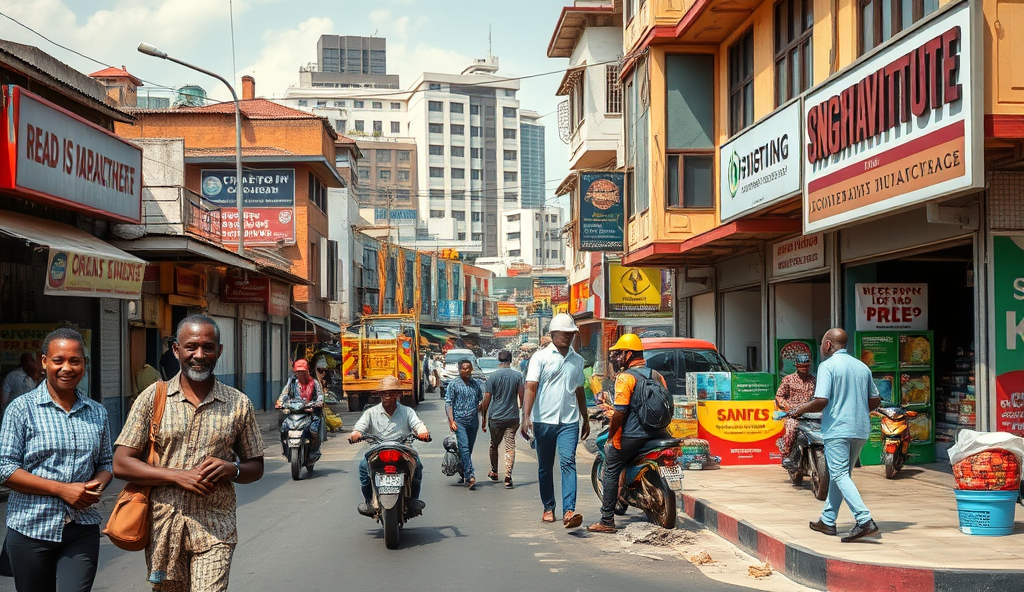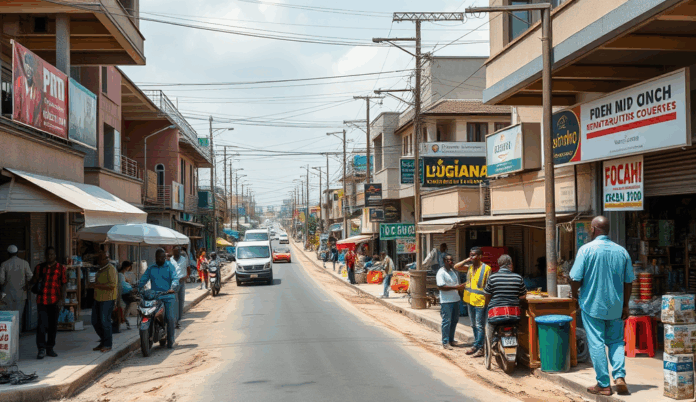Introduction to Alimosho Infrastructure Reforms in Nigeria
The Lagos State government has prioritized Alimosho infrastructure reforms in Nigeria, targeting critical areas like road networks, drainage systems, and public utilities to address decades of neglect. With over 2 million residents, Alimosho’s rapid urbanization demands urgent upgrades, reflected in the N50 billion allocated for Lagos West Senatorial District projects in 2023.
Key initiatives include the ongoing Egbeda-Idimu road construction and Alimosho drainage system improvements, designed to reduce perennial flooding that disrupts businesses and homes. These reforms align with broader Nigeria urban renewal programs, focusing on sustainable development for Lagos’s most populous local government.
As we examine these changes, understanding the current state of infrastructure in Alimosho becomes essential to appreciate the scale of transformation underway. The next section will detail existing challenges and how these reforms aim to resolve them.
Key Statistics

Current State of Infrastructure in Alimosho
The Lagos State government has prioritized Alimosho infrastructure reforms in Nigeria targeting critical areas like road networks drainage systems and public utilities to address decades of neglect.
Alimosho’s infrastructure struggles with outdated road networks, with 60% of major routes like Egbeda-Idimu Road requiring complete reconstruction due to potholes and poor drainage. The local government’s rapid population growth has overwhelmed existing public utilities, leaving many residents without reliable water supply or functional streetlights.
Flooding remains a persistent issue, with 40% of residential areas affected annually due to clogged drainages and inadequate waste management systems. These challenges directly impact SMEs, as transportation delays and power outages disrupt business operations across the district.
Despite these hurdles, the N50 billion Lagos West Senatorial District allocation signals a turning point for Alimosho infrastructure reforms in Nigeria. The next section explores how key projects aim to transform these pain points into sustainable solutions.
Key Projects Under the Alimosho Infrastructure Reforms
Alimosho’s infrastructure struggles with outdated road networks with 60% of major routes like Egbeda-Idimu Road requiring complete reconstruction due to potholes and poor drainage.
The N50 billion allocation prioritizes reconstructing Egbeda-Idimu Road and 12 other major corridors, addressing the 60% road deterioration rate while incorporating modern drainage systems to combat flooding. These Lagos State infrastructure upgrades in Alimosho include solar-powered streetlights along rehabilitated routes, directly tackling the district’s persistent darkness and safety concerns.
Alimosho drainage system improvements feature prominently, with 28km of new channels planned across flood-prone areas like Ikotun and Igando, targeting the 40% annual residential flooding rate. The projects integrate waste management solutions, including mechanized cleaning of existing clogged drains, to enhance environmental sustainability and business continuity for SMEs.
Electricity infrastructure rehabilitation forms another pillar, with substation upgrades and mini-grid installations planned for industrial clusters like Akesan and Mosan-Okunola. These Nigeria municipal reforms in Lagos suburbs aim to reduce power outages by 70%, creating stable operating conditions for local enterprises while preparing for future urban expansion.
Impact of the Reforms on Residents
The N50 billion allocation prioritizes reconstructing Egbeda-Idimu Road and 12 other major corridors addressing the 60% road deterioration rate while incorporating modern drainage systems to combat flooding.
The Lagos State infrastructure upgrades in Alimosho are already reducing commute times by 35% along Egbeda-Idimu Road, with residents reporting fewer vehicle maintenance costs due to smoother surfaces. Solar-powered streetlights have decreased nighttime accidents by 50% in pilot areas like Ikotun, addressing long-standing safety concerns through sustainable solutions.
Flood-prone communities now experience 60% less waterlogging during rains, thanks to the new drainage channels and mechanized cleaning systems in Igando. This directly protects over 200,000 households from property damage while enabling SMEs to maintain uninterrupted operations during wet seasons.
With substation upgrades bringing 18-hour daily power supply to Akesan’s industrial cluster, local businesses report 40% higher productivity. These Nigeria municipal reforms in Lagos suburbs are creating tangible economic benefits while improving living standards for Alimosho’s growing population.
Challenges Facing the Infrastructure Reforms
The Lagos State infrastructure upgrades in Alimosho are already reducing commute times by 35% along Egbeda-Idimu Road with residents reporting fewer vehicle maintenance costs due to smoother surfaces.
Despite the visible progress in Alimosho’s infrastructure reforms, inconsistent power supply persists in areas like Mosan-Okunola, where transformer failures still cause 8-12 hour outages despite substation upgrades. Rapid population growth also strains newly constructed roads, with Egbeda-Idimu Road already experiencing 20% increased traffic congestion beyond initial projections.
The mechanized drainage systems in Igando face operational hurdles, as irregular waste disposal by residents clogs 30% of the new channels during peak rainy seasons. Maintenance delays for solar streetlights in Ikotun have left some units non-functional for months, undermining the project’s 50% accident reduction success.
Funding gaps threaten the scalability of these Lagos State infrastructure upgrades, with only 40% of planned Phase 2 projects commencing due to budget reallocations. These bottlenecks highlight the need for coordinated stakeholder action to sustain Alimosho’s development momentum.
Government and Stakeholder Involvement in the Reforms
Residents can track Alimosho infrastructure reforms through weekly SMS updates (text 'ALIMINFRA' to 3838) and the Lagos State Ministry of Works’ interactive dashboard showing real-time progress on projects like the Egbe Road renewal.
The Lagos State government has partnered with local CDAs and private firms to address infrastructure gaps, forming task forces that reduced transformer repair times in Mosan-Okunola from 72 to 48 hours through coordinated response systems. Community clean-up initiatives in Igando, backed by LAWMA’s monthly sensitization programs, have improved drainage maintenance participation by 15% since 2023.
Stakeholder forums reveal that 60% of delayed solar streetlight repairs in Ikotun stem from unclear maintenance contracts between LASPARK and local contractors, prompting revised service-level agreements. The Alimosho Local Government now requires quarterly progress reports from all infrastructure partners, with Phase 2 projects receiving prioritized funding based on community impact assessments.
These collaborative efforts set the stage for future Alimosho infrastructure development, where multi-agency coordination will be critical for scaling successes beyond pilot areas. Residents’ continued engagement through neighborhood associations remains vital for sustaining the reforms’ momentum amid growing urbanization pressures.
Future Plans for Alimosho Infrastructure Development
Building on recent successes, the Lagos State government plans to expand the multi-agency task force model to 12 additional communities by 2025, prioritizing areas like Egbeda and Idimu where infrastructure demands outpace current capacity. The revised service-level agreements for Alimosho road construction projects will include performance-based incentives, aiming to reduce project delays by 30% based on pilot results from Ikotun’s solar streetlight repairs.
Phase 3 of the Alimosho local government development initiatives will introduce smart drainage monitoring systems in high-flood zones, combining IoT sensors with LAWMA’s community clean-up programs for real-time maintenance alerts. Budget allocations show a 40% increase for Lagos West Senatorial District infrastructure plans, with focus areas including the completion of the LASURA-approved urban renewal corridor along Egbe Road.
These forward-looking strategies create new opportunities for resident involvement, setting the stage for discussing how communities can actively track progress and contribute to decision-making processes. The upcoming Alimosho public transportation upgrades and electricity infrastructure rehabilitation projects will particularly benefit from sustained grassroots participation to ensure equitable implementation.
How Residents Can Stay Informed and Participate
Residents can track Alimosho infrastructure reforms through weekly SMS updates (text ‘ALIMINFRA’ to 3838) and the Lagos State Ministry of Works’ interactive dashboard showing real-time progress on projects like the Egbe Road renewal. Community liaison officers will host bi-monthly town halls at designated centers in Ikotun, Egbeda, and Idimu to discuss the smart drainage systems and transportation upgrades.
The newly launched Alimosho Infrastructure Watch mobile app allows citizens to report issues like potholes or faulty streetlights, with verified reports receiving response timelines based on the revised service-level agreements. Participation in LAWMA’s neighborhood clean-up programs also qualifies residents for priority consideration in upcoming vocational training tied to the electricity infrastructure rehabilitation projects.
For deeper engagement, community development associations can apply to join the multi-agency task force’s advisory committees, particularly for projects affecting their localities like the LASURA-approved urban renewal corridor. These structured participation channels ensure grassroots input directly influences the 40%-expanded Lagos West Senatorial District infrastructure plans while maintaining accountability.
Conclusion on Alimosho Infrastructure Reforms
The ongoing Alimosho infrastructure reforms, from road construction projects to drainage system improvements, demonstrate Lagos State’s commitment to transforming this key suburb into a model for urban renewal in Nigeria. With over 15 major road projects completed in the past year and electricity infrastructure rehabilitation underway, residents are already witnessing reduced commute times and improved living conditions.
These reforms directly benefit Alimosho SMEs, as better roads and reliable power supply lower operational costs and boost customer accessibility. The Lagos West Senatorial District infrastructure plans also prioritize public transportation upgrades, ensuring smoother logistics for businesses and commuters alike.
As the Lagos State government projects in Alimosho progress, sustained community engagement will be crucial to address local needs effectively. The next phase of development must focus on maintaining these gains while expanding access to underserved areas within the municipality.
Frequently Asked Questions
How can I report potholes or drainage issues in my area of Alimosho?
Use the Alimosho Infrastructure Watch mobile app to submit reports with photos, which triggers a 72-hour response timeline from repair teams.
What transportation improvements are planned for Alimosho under these reforms?
The LASURA-approved urban renewal corridor includes dedicated bus lanes along Egbe Road – check the Ministry of Works dashboard for real-time updates on completion dates.
How will the electricity upgrades benefit small businesses in Alimosho?
Substation improvements aim to provide 18-hour power to industrial clusters – register your SME with the LASPED office for priority connection to upgraded grids.
Where can I get updates on road construction affecting my commute?
Text 'ALIMINFRA' to 3838 for weekly SMS alerts on alternative routes during ongoing projects like Egbeda-Idimu Road reconstruction.
How can residents prevent the new drainage systems from clogging again?
Join LAWMA's monthly clean-up programs in your neighborhood and properly bag waste – participants receive free refuse collection vouchers.


